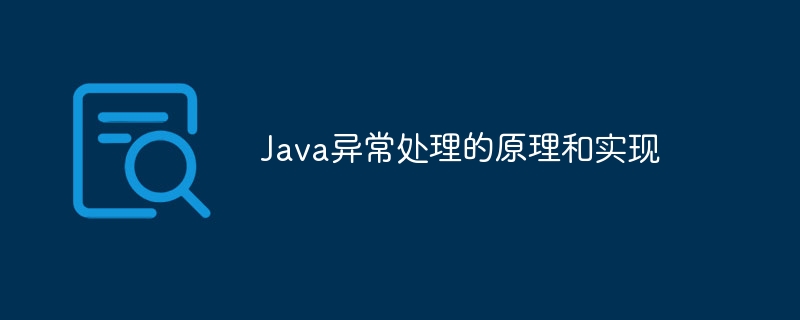Principles and implementation of Java exception handling
The function of the exception handling mechanism is to capture and handle abnormal events to improve code robustness and maintainability. The principle is based on Try-Catch blocks, exception objects, and exception hierarchies. Java programs implement exception handling by executing code that may throw an exception in a try block and catching specific types of exceptions in a catch block. Exception handling is crucial in practical applications such as file operations, database interactions, and network communications.

The principle and implementation of Java exception handling
Exceptions are events that break normal program execution. Java provides an exception handling mechanism for catching and handling these events, thereby improving the robustness and maintainability of the code.
Principle
The exception handling mechanism is mainly based on the following concepts:
-
Try-Catch block: will probably throw The code for exceptions is placed in
tryblocks, and specific types of exceptions are caught incatchblocks. -
Exception object: When an exception occurs, the Java Virtual Machine (JVM) creates an
Exceptionobject that represents the exception. This object contains information about the exception type, error message, and other details. -
Exception hierarchy: The
Exceptionclass is a parent class that derives more specific exception types (e.g.,IOException,NullPointerException). Subclasses represent more specific exceptions and can be caught by their parent class.
Implementation
The following is a simple Java program showing exception handling:
class ExceptionHandling {
public static void main(String[] args) {
// Try-Catch 块捕获除数为 0 时的 ArithmeticException
try {
int result = 10 / 0; // 异常点
System.out.println(result);
} catch (ArithmeticException e) {
// 捕获 ArithmeticException 并打印其错误消息
System.out.println("无法除以 0:" + e.getMessage());
}
}
}Practical case
Exception handling is very important in actual development, for example:
- File operation: Capture exceptions such as file opening or writing failure.
- Database interaction: Capture exceptions such as connection loss or query errors.
- Network communication: Capture network connection or data transmission exceptions.
Conclusion
Exception handling is a powerful mechanism in Java that can help developers handle unexpected events and improve the robustness and maintainability of applications. . By understanding the principles and implementation of exception handling, developers can effectively create robust code that operates normally even when exceptions occur.
The above is the detailed content of Principles and implementation of Java exception handling. For more information, please follow other related articles on the PHP Chinese website!

Hot AI Tools

Undresser.AI Undress
AI-powered app for creating realistic nude photos

AI Clothes Remover
Online AI tool for removing clothes from photos.

Undress AI Tool
Undress images for free

Clothoff.io
AI clothes remover

AI Hentai Generator
Generate AI Hentai for free.

Hot Article

Hot Tools

Notepad++7.3.1
Easy-to-use and free code editor

SublimeText3 Chinese version
Chinese version, very easy to use

Zend Studio 13.0.1
Powerful PHP integrated development environment

Dreamweaver CS6
Visual web development tools

SublimeText3 Mac version
God-level code editing software (SublimeText3)

Hot Topics
 Square Root in Java
Aug 30, 2024 pm 04:26 PM
Square Root in Java
Aug 30, 2024 pm 04:26 PM
Guide to Square Root in Java. Here we discuss how Square Root works in Java with example and its code implementation respectively.
 Perfect Number in Java
Aug 30, 2024 pm 04:28 PM
Perfect Number in Java
Aug 30, 2024 pm 04:28 PM
Guide to Perfect Number in Java. Here we discuss the Definition, How to check Perfect number in Java?, examples with code implementation.
 Random Number Generator in Java
Aug 30, 2024 pm 04:27 PM
Random Number Generator in Java
Aug 30, 2024 pm 04:27 PM
Guide to Random Number Generator in Java. Here we discuss Functions in Java with examples and two different Generators with ther examples.
 Weka in Java
Aug 30, 2024 pm 04:28 PM
Weka in Java
Aug 30, 2024 pm 04:28 PM
Guide to Weka in Java. Here we discuss the Introduction, how to use weka java, the type of platform, and advantages with examples.
 Armstrong Number in Java
Aug 30, 2024 pm 04:26 PM
Armstrong Number in Java
Aug 30, 2024 pm 04:26 PM
Guide to the Armstrong Number in Java. Here we discuss an introduction to Armstrong's number in java along with some of the code.
 Smith Number in Java
Aug 30, 2024 pm 04:28 PM
Smith Number in Java
Aug 30, 2024 pm 04:28 PM
Guide to Smith Number in Java. Here we discuss the Definition, How to check smith number in Java? example with code implementation.
 Java Spring Interview Questions
Aug 30, 2024 pm 04:29 PM
Java Spring Interview Questions
Aug 30, 2024 pm 04:29 PM
In this article, we have kept the most asked Java Spring Interview Questions with their detailed answers. So that you can crack the interview.
 Break or return from Java 8 stream forEach?
Feb 07, 2025 pm 12:09 PM
Break or return from Java 8 stream forEach?
Feb 07, 2025 pm 12:09 PM
Java 8 introduces the Stream API, providing a powerful and expressive way to process data collections. However, a common question when using Stream is: How to break or return from a forEach operation? Traditional loops allow for early interruption or return, but Stream's forEach method does not directly support this method. This article will explain the reasons and explore alternative methods for implementing premature termination in Stream processing systems. Further reading: Java Stream API improvements Understand Stream forEach The forEach method is a terminal operation that performs one operation on each element in the Stream. Its design intention is






